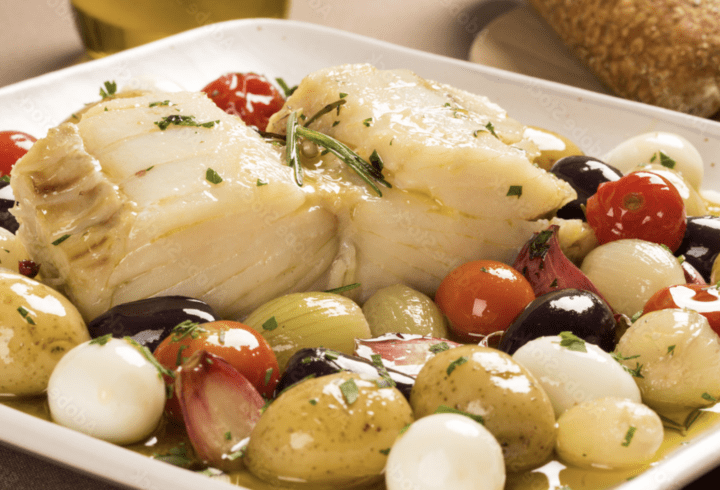Portuguese Bacalhau a Bras
Portuguese Bacalhau a Bras
Bacalhau à Brás is a Portuguese dish made from shreds of salted cod, onions, and thinly chopped fried potatoes, all bound with scrambled eggs. It is usually garnished with black olives and sprinkled with fresh parsley. The history of Bacalhau in Portugal is a fascinating tale of discovery, necessity, and adaptation, stretching back centuries and intricately linked to the country's maritime and cultural evolution. The culinary traditions surrounding Bacalhau in Portugal are as diverse and fascinating as the fish itself. Below is a deeper dive into the ways Portugal has embraced and transformed this salty treasure. We hope that this Portuguese Bacalhau a Bras post inspires you.

Portuguese Bacalhau a Bras
Portuguese Bacalhau a Bras
Early Encounters (14th-15th Centuries)
- Portuguese explorers, venturing out during the Age of Discovery, first encountered the abundance of cod fish off the coasts of Newfoundland and Iceland.
- Recognizing its potential as a valuable food source, they began experimenting with salt preservation techniques, a common practice to prevent spoilage during long voyages.
- Salted cod, known as Bacalhau, became a vital part of the ship's provisions, ensuring protein sustenance for sailors on lengthy journeys.
From Necessity to Staple (15th-17th Centuries)
- The practice of salting and importing Bacalhau soon reached mainland Portugal, finding its way into coastal communities and gaining popularity due to its affordability and practicality.
- Catholic fasting practices, which prohibited meat consumption on certain days, further amplified the appeal of Bacalhau as a versatile and satisfying alternative.
- Portuguese ingenuity blossomed, resulting in the development of countless recipes, transforming the once simple salted fish into a culinary cornerstone of Portugal's identity.
Famous Portuguese Dishes
Evolution and Expansion (18th-20th Centuries)
- The trade routes for Bacalhau expanded beyond Newfoundland, reaching Norway and other regions with abundant cod populations. This ensured a consistent supply of the prized fish.
- Bacalhau's influence transcended Portugal's borders, finding its way to former colonies and influencing cuisines in Brazil, Angola, and other parts of the world.
- Throughout the centuries, the culinary repertoire surrounding Bacalhau continued to evolve, with countless regional variations and family-secret recipes emerging, making it truly a dish of the people.
Contemporary Significance (21st Century)
- Today, Bacalhau remains an integral part of Portuguese culture and cuisine. It features prominently in festive meals, family gatherings, and everyday menus.
- Portugal boasts the highest per capita consumption of cod globally, a testament to its enduring popularity and significance.
- The historical journey of Bacalhau has shaped Portugal's culinary identity, leaving a legacy of resourcefulness, creativity, and a deep appreciation for the humble, yet versatile, salted cod.
Regional Variations
- North: Known for hearty, broth-based dishes like Bacalhau à Zé do Pipo (with chickpeas and vegetables) and Bacalhau à Minhota (stewed with potatoes and cabbage).
- Center: Features oven-baked preparations like Bacalhau à Lagareiro (with olive oil, garlic, and onions) and Bacalhau à Gomes de Sá, which originated in Coimbra.
- South: Offers lighter recipes like Bacalhau à Algarvio (marinated in tomato and herbs) and Bacalhau à Brás, popular in Lisbon and across the country.
Best Food in Porto Portugal
Religious Significance
- Bacalhau has long been a staple during religious holidays, particularly Christmas Eve (“Consoada”). Its symbolic purity and durability made it a suitable choice for periods of fasting.
- Traditional Christmas Eve dinners often feature Bacalhau cozido (boiled with vegetables) or Bacalhau na brasa (grilled).
Family Recipes and Secrets
- Every family boasts its own secret Bacalhau recipe, passed down through generations. These recipes often incorporate local ingredients and reflect regional preferences.
- The process of soaking and desalinating the cod is considered an art form, with families employing their techniques and traditions.
Modern Interpretations
- While respecting the classics, modern chefs are pushing the boundaries with innovative Bacalhau dishes. Molecular gastronomy, fusion cuisine, and lighter preparations are finding their way onto menus.
- Contemporary restaurants might offer Bacalhau tartare, black cod dumplings, or Bacalhau mousse, reinterpreting the classic with new techniques and flavors.
- https://divinelifestyle.com/portuguese-caldo-verde-soup/
Beyond the Fish
- Bacalhau's culinary influence extends beyond the main course. It can be found in soups, stews, croquettes, and even desserts like Bacalhau de chocolate (a chocolate mousse with a salty twist).
Experiencing the Traditions
- To truly appreciate Bacalhau's culinary traditions, immerse yourself in local experiences. Visit traditional markets to observe the selection and preparation of the fish.
- Ask local families about their favorite recipes and attend food festivals celebrating Bacalhau.
- Don't hesitate to try different regional variations and discover your own unique Bacalhau story.
Remember, Bacalhau is more than just food; it's a journey through Portuguese history, culture, and family traditions. So, savor each bite and dive deep into the culinary world of this iconic fish! We hope that this Portuguese Bacalhau a Bras post inspires you. Happy travels!
Best Things to Do in Porto Portugal
You May Also Like
